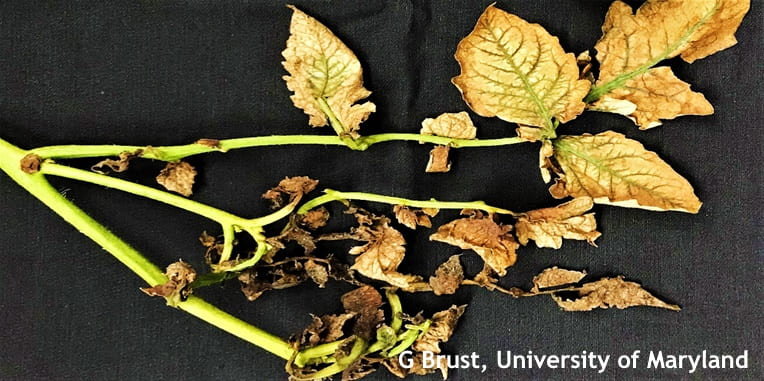Jerry Brust, IPM Vegetable Specialist, University of Maryland; jbrust@umd.edu
A grower was having symptoms of twisted foliar growth and browning/bronzing of their tomato leaves and fruit. The problem was broad mites (Polyphagotarsonemus latus). Usually, we do not see broad mites as a problem in May in our high tunnel tomatoes. However, the grower did not clean up their high tunnel from last fall’s tomato crop until several weeks before they planted their spring crop of tomatoes. Unfortunately, there was a small infestation of broad mites in the fall crop of tomatoes that was able to overwinter. It is important that growers clean up their high tunnel or greenhouse (GH) well in advance of another crop in case there is a small infestation (or disease problem) that had started in the last crop. Sanitation is key to keeping pest problems out of a high tunnel or GH.
Female broad mites are oval, 0.2 mm long and are yellow or green with an indistinct, light, median stripe that forks near the back end of the body. Males are similar in color but lack the stripe. The translucent, colorless oval eggs are firmly attached to the surface of a leaf. The eggs are very distinctive and are usually used to identify whether or not broad mites are present (often times adults or immatures cannot be found on a sample, but the eggs will be). The eggs are covered with scattered white tufts on their outer surface that look like round dots (Fig. 1). Immature broad mites are white and slow moving. After just one day, the larva becomes a quiescent nymph which is clear and pointed at both ends. When females emerge from this quiescent stage, males immediately mate with them. Adult females lay a total of 30 to 76 eggs on the undersides of leaves and in the depressions of small fruit over an eight- to 13-day period and then die. Adult males may live five to nine days. While unmated females lay eggs that become males, mated females usually lay four female eggs for every male egg. Males and females are very active, but the males evidently account for much of the dispersal of a broad mite population when they carry the quiescent female to new leaves.
Hosts
The broad mite has a wide range of host plants: apple, avocado, cantaloupe, castor, chili, citrus, coffee, cotton, eggplant, grapes, guava, jute, mango, papaya, passion fruit, pear, potato, sesame, string or pole beans, tea, tomato and watermelon. Broad mites also infest many ornamentals, including African violet, ageratum, azalea, begonia, chrysanthemum, cyclamen, dahlia, gerbera, gloxinia, ivy, jasmine, impatiens, lantana, marigold, peperomia, pittosporum, snapdragon, verbena, and zinnia. Their ability to attack both vegetables and ornamental plants make them especially troublesome in greenhouses that grow both.
Damage
The damage caused by broad mites can look similar to the damage caused by viruses, herbicides or nutrient deficiencies. They feed on plant cells within the leaf epidermis using their piercing-sucking mouthparts. Early feeding is mainly concentrated near the growing point on the underside of a leaf near the stalk, which tends to cause the leaf to curl and become twisted and distorted (Fig. 2). More serious infestations cause leaf bronzing leaving the main veins green against the brown leaf tissue that eventually turns black, shrivels and dies (Fig. 3). Corky patches frequently appear on fruits that often crack at the site of deformation (Fig. 4). Extensive damage can be caused by relatively low populations. Commonly, the lower leaves of a plant can remain unaffected while the younger leaves are badly damaged. Symptoms of feeding damage can remain visible several weeks after the mites have been removed. Therefore, after treatments the plants need to be checked again for the presence of the mite, even though damage may still be apparent.
Management
Once the mites have been positively identified as the cause of the tomato deformities horticultural oils or sulfur can be used that produce results similar to synthetic chemical applications. The most important aspect of the application is thorough coverage. The material needs to get down into tightly wrapped growing points and to the underside of leaves. Be careful when applying the oils or sulfur as they can cause phytotoxicity under hot humid conditions. Portal XLO has been found to control broad mites in tomato (IRAC subgroup 21A) and should be rotated with other miticides (hort oils, sulfur, Oberon, Agri-Mek, etc.) that have a different mode of action (i.e., a different IRAC No.). As in the case of oils and sulfur Portal is a contact miticide and for best performance uniform and thorough spray coverage is needed. The addition of a nonionic wetting or penetrating adjuvant to the synthetic chemicals is recommended to improve their performance.

Figure 1. Broad mite egg greatly magnified.

Figure 2. Leaves of tomato twisted and deformed by broad mite feeding

Figure 3. Severe broad mite feeding causing bronzing of leaves–leaving green veins

Figure 4. Damaged and aborted cherry tomato fruit due to broad mite feeding
